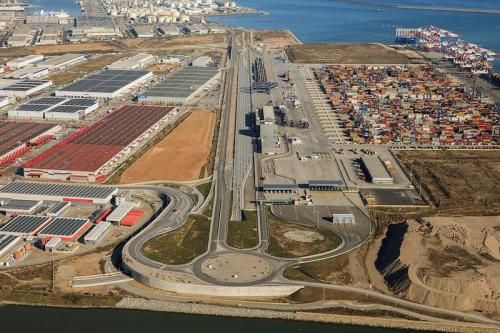
Project leader
States involved
The project
Project focused on the adaptation of the Port of Barcelona railway network to the standard gauge (UIC) reinforcing the policy of the European Commission and the TEN-T to improve existing railway infrastructures, eliminate restrictions and harmonise technical parameters to contribute to the transition from road to rail transport, considered more sustainable.
Project Activities
- Construction of rail access to the Prat terminal in UIC gauge: the adaptation of the southern access, the current infrastructure and various crossing points, allows access to areas of the Port in UIC gauge. This activity also included the connection of the new Prat Wharf terminal to the rest of the railway line.
- Adaptation of the 'contrabucle' to the UIC gauge: through this, direct connection of the container terminals located in South Dock and Príncipe de España Dock.
- Construction of the rail access to the Energía Dock in UIC gauge: adaptation of the access roads to the terminals located in the Energía Dock, and the construction of a new UIC crossing connecting it with the Prat Wharf. Due to the proximity of the motor vehicle terminals to the Energia Dock, this activity will make possible the development of services for the transport of motor vehicles.
All built and adapted sections are fully operational.
Benefits and results
The biggest benefit of the project is the reduction in time and cost of rail freight operations, improving the connection of the Port of Barcelona with the Mediterranean Corridor. The new internal interconnection between terminals in double gauge (Iberian and UIC), allows the intermodal connection by rail as an alternative to the road.
And the results obtained with the activities are:
- Extension of the connection with UIC gauge to various terminals, thus improving train traffic between different terminals that use UIC gauge.
- Construction of 885 metres of double gauge track: UIC and Iberian.
- Adaptation of 5,596 metres of track to double gauge (UIC and Iberian) and 300 metres to triple gauge (UIC, Iberian and metric).
- Adaptation of diversions and double gauge crossings.
Increased competitiveness
The incorporation of UIC gauge tracks has increased operability of the Port of Barcelona and improved its accesses and, consequently, increased the transport of goods by rail to different European countries.
The adaptation of the connections to European connection points and abroad, has also increased connections between Barcelona's hinterland and its geographical area of influence. This improvement in the infrastructure of the Port of Barcelona has led to the incorporation of new rail operators who have in turn developed more rail connection services from the port area.
Reduction environmental impact
The UIC gauge connection of the Prat Wharf terminal with the rest of the Port area has made internal freight transport possible by rail and in 2013, the first year the connection was operational, 39,680 TEUs were transported in this terminal. Only during that year, the impact of this change in the transport of containers meant a saving in negative externalities of about 2.57 million euros.
Also in 2013, the transport of containers by rail in the Port of Barcelona was 10.7% while the average for Spanish ports was 4.1%. This change from transport by truck to transport by rail has reduced the environmental impact in the metropolitan area of Barcelona and by 2020, it is estimated that the reduction of CO2 emissions will be 82%, compared to the same road traffic.
Participation of the Barcelona Port Authority
The Port of Barcelona has been responsible for establishing a general plan of action, as well as its compliance, and for guaranteeing the proper administration of the Action in matters of financial and information management, and quality assurance. The coordination and monitoring of the global action were carried out throughout the project.



